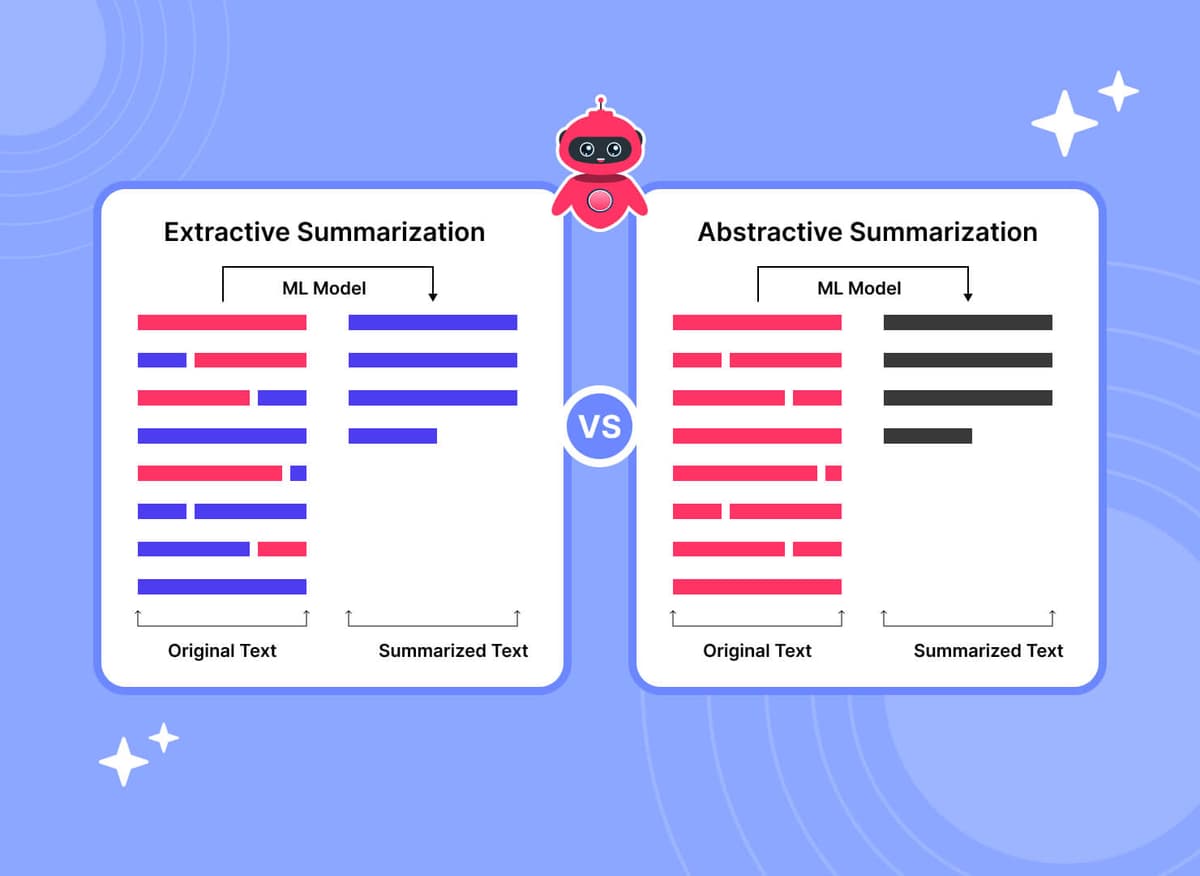


Aug 05, 2025
-
By Clive

![]() AI Summary By Kroolo
AI Summary By Kroolo
Reading 10,000 words to find that one golden paragraph? We’ve all been there. With 328 million terabytes of data created daily (Statista, 2025), the ability to consume more in less time is now a necessity, not a luxury.
AI-powered summarization tools—like Kroolo’s free AI Summarizer—have reimagined how we consume content. But beneath the simplicity of a “Generate Summary” button lies a powerful debate: Extractive vs Abstractive Summarization.
Which one truly captures the essence of a document?
How do they differ in practice—not theory?
Let’s break them down, step by step, with examples.
Summarization in AI involves condensing lengthy content into a shorter form while retaining the key meaning. This is achieved using NLP techniques. A Nielsen study found that readers only spend 20–28% of their time on a web page reading the actual content. Further, 63% of professionals now use AI summarizers at least once a week to boost productivity (Gartner, 2024).
Summarization has gone from a luxury to a necessity. But not all summaries are built the same—this brings us to the two pillars: Extractive and Abstractive Summarization.

Extractive summarization works like a highlighter pen. It selects the most important lines from the original text without changing the wording or sentence structure. There’s no paraphrasing—just picking the best bits and pasting them together.
Example: Extractive Summary in Action
Original Text:
“Artificial Intelligence is rapidly evolving. It’s being adopted in fields like healthcare, marketing, and education. AI tools like summarizers help users consume large volumes of information in seconds. Businesses save time and improve productivity using these technologies.”
Extractive Summary Output:
“Artificial Intelligence is rapidly evolving. AI tools like summarizers help users consume large volumes of information in seconds. Businesses save time and improve productivity using these technologies.”
💡 Note: No change in sentence structure. It's copy-paste from the source, but smartly selected.
Abstractive summarization is like asking a friend to explain something in their own words. It rewrites the original content by understanding the context, and then generates new sentences that express the same ideas—but more fluently and concisely.
Example: Abstractive Summary in Action
Original Text:
“Artificial Intelligence is rapidly evolving. It’s being adopted in fields like healthcare, marketing, and education. AI tools like summarizers help users consume large volumes of information in seconds. Businesses save time and improve productivity using these technologies.”
Abstractive Summary Output:
“AI is transforming industries by enabling faster information processing and improving productivity across healthcare, education, and business.”
💡 Note: Completely rephrased. More fluent. More human.
|
|
|
|
|
|
|
|
|
|
|
|
|
|
|
|
|
|
|
|
|
|
|
|
|
|
|
|
|
|
|
|
|
|
|
|
|
|
|
|
|
|
|
|
|
|
|
|
|
|
|
|
|
|
|
|
|
|
|
|
|
|
|
|
As AI continues to become a daily workplace ally, the choice between extractive and abstractive summarization depends largely on industry needs, content type, and risk tolerance. But when we zoom out and look at adoption data, extractive summarization still holds the majority share.
✅ 2025 Industry Adoption Statistics (Source: NLP Index Annual Survey)
|
|
|
|
|
|
|
|
|
|
|
|
Here are the following reasons which makes extraction summary leads the row:
Extractive summarization is deterministic—it uses existing sentences from the text, so there's no risk of AI "hallucinating" facts or misinterpreting context. For industries like law, academia, and healthcare, this factual integrity is non-negotiable.
Extractive models require less computational power, making them cheaper and faster to deploy in enterprise-scale systems.
Because the summary retains original phrasing, human validation becomes easier, especially in regulated environments where accuracy trumps style.
On the contrary, here is the reasons why the abstractive summary is the rising start:
The rise of transformer-based models (like GPT, BART, T5) has unlocked a new era in context-aware summarization that mimics human tone and expression. This has made abstractive summaries more desirable for CX, sales enablement, and internal communications.
Abstractive summarization tends to compress content further, making it ideal for executives who want quick takeaways, not full paragraphs.
It shines in contexts where tone, clarity, and flow are essential—like blog synopses, newsletters, or customer support summaries.
A few things are giving major setbacks to the adoption of the abstractive summary. Read them aloud below:
Abstractive models can sometimes generate incorrect or misleading content, especially with niche or technical topics.
These models require more training data, compute power, and fine-tuning, making them less appealing for small to mid-sized teams.
“Abstractive summarization is where the future is heading, but until we solve reliability and performance constraints at scale, extractive summarization remains the default in mission-critical fields.”
— Dr. Leah Moretti, Head of NLP Research, Cogniva AI Labs
Many modern summarizers—including Kroolo AI Summarizer—are already moving toward hybrid models. These combine the accuracy of extractive with the natural fluency of abstractive, giving users the best of both worlds.
In fact, by late 2026, the market is expected to shift to a 55/45 extractive-abstractive split, with hybrid approaches taking center stage across most industries.
🔹 Extractive summarization dominates industries where factual accuracy and compliance are critical.
🔹 Abstractive summarization is rising fast—especially in content-heavy roles (CXOs, marketers, internal comms).
“Abstractive summaries are better at sounding human. But extractive ones are better at being safe.” — [NLP Weekly, 2025]
Kroolo AI Summarizer gives you the best of both worlds—for free. Here are the characteristics of the kroolo AI summarizing tool.
It uses GPT-based language models with summarization layers for enhanced fluency and factual integrity.
Try it for:
🔹 Research articles
🔹 Legal agreements
🔹 Meeting transcripts
🔹 Blog-to-summary workflows
🔹 Product documentation
Tags
Project Management
Productivity